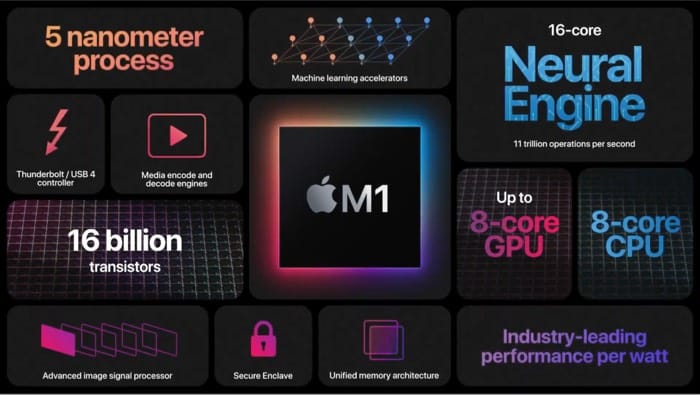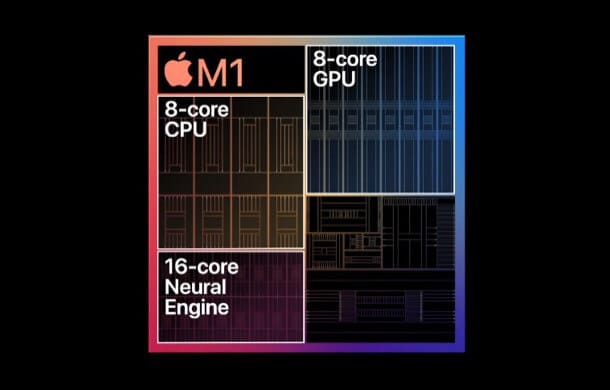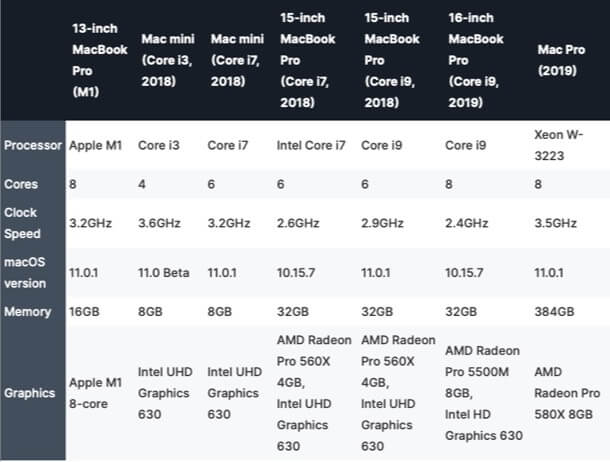There’s an entire list of innovative products and friendly services that the Cupertino-based tech giant introduced this year. Still, the M1 chip – a resident, Arm-architecture system-on-chip (SoC) for Macs can be called by far the most significant innovation of the year.

Boasting the first-ever 5-nanometer process and highest performance 8-core CPU, the first-generation Apple Silicon Chip promises efficiency and power.
However, considering that the technology is relatively new and there would be numerous questions related to that, I have tried to fit almost all queries into a handy place. Before starting, let’s quickly sneak into the innovation and what the experts have to say about it.
Video: Apple M1 Chip Explained and Answered All Your Questions
Introducing the M1 Chip. It’s Fast, Faster, and Fastest!!!
Replacing the traditional Intel chips, Apple introduced an M1 chip, also called Apple Silicon Chip, for smoother and enhanced performance.
“The M1 chip is by far the most powerful chip that we have ever created.”
– Tim Cook
And with the initial testing and analysis, this sounds true. Nevertheless, we can’t deny that it’s fresh and numerous questions linked with it, would be juggling to and fro, finding no pitstop with answers to all of them.
Well, the search ends here. Keep scrolling to find an answer to almost all the questions you might have related to Apple’s M1 chip.
- What is Apple M1 Chip?
- Why Apple Introduced M1 Chip?
- M1 Chip vs. Intel – How M1 is Different from Intel? Is M1 Faster?
- Will M1 Help Save Battery Life?
- Is the New MacBook Air Fanless?
- Which Apps work with M1 Macs?
- Should I Buy M1 Macs? Which Models have M1 Pre-Installed?
- How Will M1 Chip Benefit Students?
- How will M1 Chip Help Professionals?
- Will M1 Chip Make Macs Cheaper?
- Will M1 Change the Way I Use my Mac?
- Can I Still Buy Intel Macs from Apple?
What is Apple M1 Chip?
M1 is the first-ever, specifically designed chip for Mac. It is engineered using innovative 5-nanometer process technology and 16 billion transistors that deliver dramatically improved efficiency and unmatched performance.

The chip houses the fastest CPU core, the world’s fastest integrated graphics, most advanced machine learning, and best CPU performance/watt. This allows M1 to deliver up to;
- 3.5x faster CPU performance.
- 6x faster GPU performance.
- 15x faster machine learning.
- 2x longer battery life is compared to preceding Macs.
Why Apple Introduced M1 Chip?
Nothing can answer this as much as the quote, “Necessity is the Mother of Innovation.” The best thing about technology is that it keeps evolving. With the release of the M1 chip, Apple moved closer to its vision of building a unified ecosystem that’s secured and powerful.

Tim further announced that all the apps would be soon developed to support all the devices. This will further enhance the security and privacy of users across Apple devices. It’s undoubtedly a significant step for the company.
M1 Chip vs. Intel – How M1 is Different from Intel? Is M1 Faster?
The first difference between the two processors is that M1 is Apple’s home production to replace the traditional Intel processors, powering the Mac devices. It utilizes ARM-architecture, the power behind iPhones, iPads, and other consumer-oriented electronic devices.
In comparison to x86 architecture, ARM works on a simplified set of instructions, allowing the device to consume lower power.

The newly launched processor features a 16-core Neural Engine with the capacity to offer 11 trillion operations per second. It also comes with 16 billion transistors, a unified memory architecture, media encode & decode engines, and much more. It unleashes an all-new experience for Mac users.
Will M1 Help Save Battery Life?
Apple claims that the M1 Macs sport the best battery life ever on a Mac.
This is one of the pros of the newly introduced chip. It has been tried and tested by several tech enthusiasts, and the results were positive. The first-ever Apple Silicon Chip allows MacBook Air to deliver up to 15 hours of web browsing and 18 hours of movie playback. The device comes with a 49.9WHr battery. While in the preceding generation, the performance was confined to 11 and 12 hours, respectively.
Taking performance a step further, its closest sibling, MacBook Pro, is equipped with a 58.2 WHr battery and offers 17 hours of browsing and up to 20 hours of video experience. The previous generation could last only up to 10 hours in both scenarios.
Besides battery life, there are numerous other features boasting capabilities of M1 Chip. The list includes blazing fast performance, advanced security, universal apps, etc.
Is the New MacBook Air Fanless?
Yes, the new MacBook Air doesn’t have a cooling fan. As a matter of fact, the original 13-inch MacBook had a fanless design too, but it featured a weaker Intel processor. However, MacBook Pro and Mac mini will both have cooling fans.
Which Apps Work with M1 Macs?
Considering this one’s a recent launch and includes an entirely new architecture, Apple has opened support doors for developers to increase their list of M1-compatible apps. However, soon after its launch, most commonly used apps like Chrome, Firefox 84 Beta, Microsoft Office, Pixelmator Pro, Photoshop, World of Warcraft, and Apple’s home apps like Final Cut Pro and Logic Pro were updated.
We can expect to have a good number of supportive apps for macs running on M1 pretty soon.
Should I Buy M1-powered Macs? Which Models have M1 Pre-Installed?
Currently, M1 comes installed in Mac Mini, MacBook Air 13-inch, and MacBook Pro 13-inch. You can buy these devices (available in 256 GB and 512 GB variants) for a starting price of $699, $ 999, and $1299, respectively.
The new Macs with Big Sur will redefine the computing experience at comparatively low prices—especially Mac Mini. If you have other peripherals like a keyboard, mouse, etc., Mac Mini can undoubtedly be a smart buy.
However, to understand the need better, it’s essential to know the purpose of your profession. Having said this, if there’s any particular app that you need to serve the purpose, it’ll be wise to check app compatibility first
How Will M1 Chip Benefit Students?
The M1 chip brings the Apple Neural Engine to Mac, enabling it to deliver game-changing speed and battery life. This will help students unleash their full capabilities and do more in less.
However, M1 just got launched, and developers are still exploring codes to match its capabilities. It’s wise to wait until app compatibilities are attained.
How Will M1 Chip Help Professionals?
The new M1 chip will prove to be of great use for games, video editors, developers, marketers, architectural visualizers, etc. Thanks to its high-performance metrics and long battery life. I would suggest checking compatibility before making a decision or waiting for some time.
Will M1 Chip Make Macs cheaper?
If we compare M1-powered macs with those having Intel processors, you’ll notice a good price difference between the models. This is just the beginning. In coming models, we can surely expect to have more affordable Macs shortly.
We know you are in love with the new chip, but there’s no way you can have M1 Chip on old Macs for now. Perhaps, it won’t be possible in the future as well due to compatibility. A powerful chip requires numerous other factors to work seamlessly, and earlier models might not fit the ‘qualifiers.’
Will M1 Change The Way I Use My Mac?
Undoubtedly. The release of Apple Silicon Chip has opened an all-new horizon giving you endless scope to work faster and smarter. Besides performance, it’ll also transform the way you interact with your Mac and other Apple devices. Experts believe it should take the next couple of months to have an in-depth idea.
Can I still buy Intel Macs from Apple?
While Apple’s M1 chip is the way ahead for its future Macs, the brand continues to sell Intel Macs. Apple’s current lineup of Intel-based processors includes MacBook Pro, Mac Mini, Mac Pro, iMac Pro, and iMac.
Have more questions related to M1? Feel free to connect in the comment section.
You may also like to read these:
